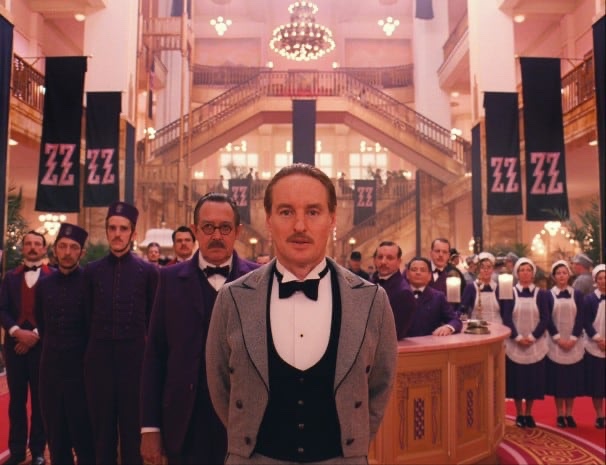Chapters 28 to 29 in the film show Dmitri (Adrian Brody) chasing Agatha (Saoirse Ronan) since she has the painting Boy With Apple.
The sequence begins with an establishing shot, which establishes the location and time of the coming scene by showing an extreme wide-shot of the Grand Budapest hotel at night. This shot then cuts to multiple fast-paced and snappy shots of things like keys and shakers with the fascist army’s symbol on, showing to the audience that they are now in control of the hotel.
These shots occur in sequence, making it continuity editing. Here it shows Agatha walking up to a desk and handing over a cake. We, the audience, know from editing in other films, that when the camera cuts to the hotels new concierge, that this takes place at the same time of Agatha approaching the front desk. This is parallel editing, when two sequences that are continually edited are played next to each other, and take place in the film at the same time.

There is then an example of glance-object editing when Agatha looks at something, and then we see a close-up of that thing she was looking at. There is also another instance where parallel editing is used when we see M. Gustav (Ralph Fiennes) and Zero (Tony Revolori) outside in a delivery van. We know that this takes place at the same time as Agatha receiving the painting from the vault.
The sequence then enters back into straight continuity editing when Agatha is noticed by Dmitri, who begins o chase her. When he sees here, however, a quick mugshot is inserted for the audience to understand how Dmitri recognises her. the ensuing chase scene is quite an unconventional one, since there are very few cuts, leading to long takes, as is the style of Wes Andersons directing.

The parallel editing ends when Agatha and Dmitri enter the same elevator, so the previous shots of them separately have joined together. In this elevator we see Agatha is visibly afraid, and then the camera cuts to Dmitri to show the audience what she is afraid of.
There is then a classic shot-reverse-shot to show that Dmitri and Gustav are making direct eye contact as they shout across the room at each other. just before the gunfight begins, we see multiple soldiers poking their heads out of their individual rooms. The way that it goes from one man to another on the opposite side of the room creates a satisfying rhythm to the moment. When Zero looks off the balcony, a shot-reverse-shot is done to show that he is looking down at her. There is then an instance of cross-cutting when the scene cuts from Zero to Agatha, and then the scene enters continuity editing when he joins her on the balcony. The scene ends with a birds-eye shot of Zero and Agatha looking up at the camera, and then a close-up of the second copy of the second will to show what it is that they were looking at.
Back on track. Good stuff…
LikeLike